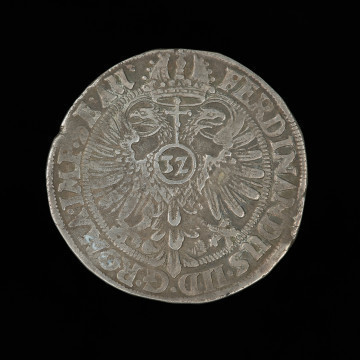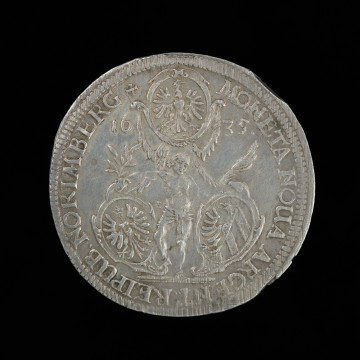
Thaler of the Reich
1621
National Museum in Szczecin
Part of the collection: German coins
From the early Middle Ages onwards Lüneburg's salt works were the source of the town's income and the driving force behind its growth. Thanks to the salt needed to preserve Baltic herring, Lüneburg became one of the wealthier and larger cities in the region and one of the first members of the Hanseatic League. The period of the town's greatest prosperity fell on the first half of the 16th century. Its quick economic growth is evidenced by the thaler – minting silver coins was so expensive that only the richest cities could afford it. On the reverse, there is a depiction of the sickle of the moon with a human face. It is a speaking emblem of the city and a reference to the popular medieval origin of its name – Luneburgum or Lunaburgum in Latin. The word luna denotes the Moon in Latin, which is why Lüneburg was commonly referred to as the Moon City. The above theory, as well as the motif of the moon on the coin, corresponds with the Latin inscription placed around the edge – a paraphrase of chapter 1, verse 78 from the Gospel of St. Luke. Luke – Came to us from heaven. The motif of the sickle of the moon with a human face was used on coins mainly in the first half of the 16th century. In the 1960s it was replaced by the two-headed eagle of the Reich, as well as the name of the reigning emperor, although Lüneburg was never an imperial city in the legal sense of the word. At the beginning of the 17th century and during the Thirty Years' War, this design became standardised, while the crescent was only an additional element, and only on commemorative thalers. It was never a part of Lüneburg's official coat of arms, but it was well-known as the hallmark of the city. The thaler is thus an example of using a coat of arms as a distinctive sign, clearly associated with the place of its issue.
Mieszko Pawłowski
Other names
Taler
Author / creator
Dimensions
cały obiekt: diameter: 40.8 mm
Object type
coin, money
Technique
minting
Material
silver
Creation time / dating
Creation / finding place
Owner
National Museum in Szczecin
Identification number
Location / status

1621
National Museum in Szczecin

1624
National Museum in Szczecin

1559
National Museum in Szczecin
DISCOVER this TOPIC
Castle Museum in Łańcut
DISCOVER this PATH
Educational path